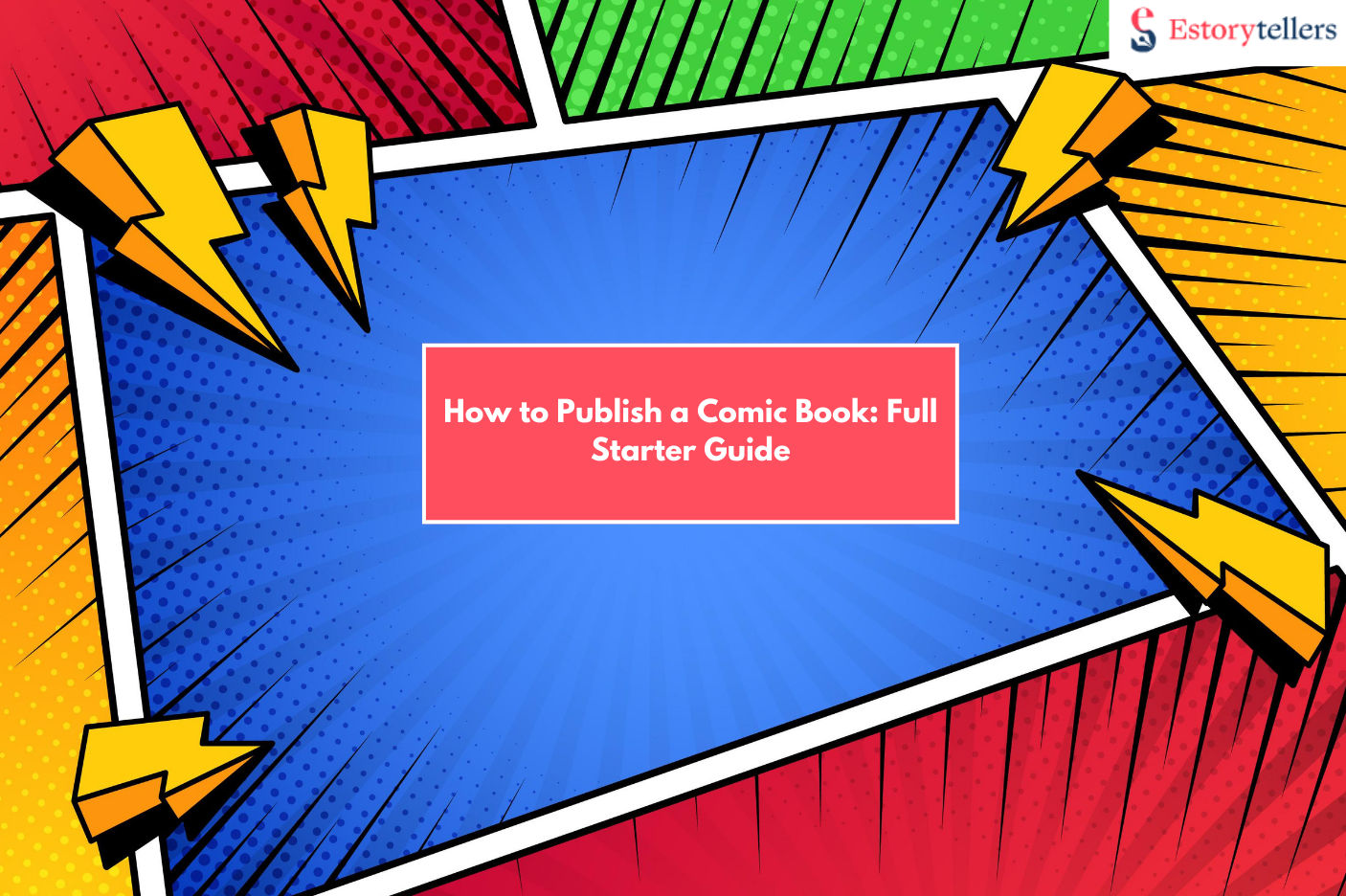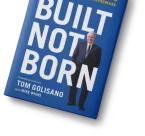
Ever wondered how to publish a comic book or how to self publish a comic book successfully? From a single-issue print comic to a full-length graphic novel or a webcomic, turning your ideas into a published comic requires careful planning, creative teamwork, and smart distribution.
In this guide, we cover every step: defining your comic’s format, building your story and script, assembling a creative team, storyboarding and designing pages, producing and proofing artwork, choosing a publishing path (digital, print, or hybrid), pre-launch marketing, launching strategically, growing your audience, and expanding your comic into sequels, merchandise, or global distribution. Along the way, you’ll see how Estorytellers can support every stage—from concept and illustration to printing, marketing, and global reach—making publishing comics easier, faster, and professional.
1. Define Your Format & Choose the Right Publishing Platform
If you’re wondering how to publish a comic book, the first step is deciding its format. Your choice impacts cost, audience reach, and even how readers experience your story.
Popular formats include:
- Single-issue print comics (classic 32–48 pages, perfect for episodic storytelling)
- Graphic novels (longer, book-style narratives with greater depth)
- Webcomics (serialized, accessible to global audiences instantly)
- Digital-first stories (optimized for tablets and e-readers)
If your goal is print, platforms like Mixam, Blurb, IngramSpark, and Estorytellers make publishing a comic book affordable through Print-on-Demand. For digital-first releases, vibrant communities exist on Webtoon, Tapas, and GlobalComix, giving indie creators instant exposure.
Estorytellers provides specialized services for comic publishing in India and globally—covering design, layout, ISBN registration, and distribution. This makes how to self-publish a comic book easier than ever, without the hassle of managing multiple vendors.
Tip: Decide early if you want a collectible print edition, a scrolling digital experience, or both. Hybrid strategies (digital launch followed by a limited print run) often generate the most buzz.
Estorytellers offers a full comic book publishing service that includes design, printing, and global distribution. They handle everything so you can focus on storytelling.
Bring Your Comic Book to Life
From vibrant illustrations to professional printing, Estorytellers helps you publish comic books that captivate readers of all ages.
2. Build a Strong Creative Team
Behind every successful comic book is a team that balances storytelling with stunning visuals. Even if you’re a solo creator, knowing the roles involved helps you plan better.
Key creative roles in comic publishing include:
- Writer/Creator – develops the script, dialogue, and pacing.
- Penciller & Inker – sketch and refine the artwork to bring characters to life.
- Colorist – adds tone, depth, and mood through colors.
- Letterer – designs the speech bubbles, sound effects, and captions for smooth readability.
- Editor – ensures consistency, corrects errors, and keeps the project on track.
For indie creators asking how to publish a comic book, collaboration is crucial. Platforms like DeviantArt, ArtStation, and Reddit communities connect writers with freelance artists and colorists. Alternatively, Estorytellers offers an end-to-end solution by pairing writers with illustrators and editors, streamlining the process of self publishing a comic book.
Tip: Even if you can’t afford a full team, never compromise on editing and lettering—these two elements strongly influence how professional your comic feels.
Estorytellers has a writer’s blog with tips on constructing compelling dialogue and pacing.
3. Storyboarding & Design: Shaping the Flow of Your Comic
Once your team (or solo workflow) is in place, the next step in how to publish a comic book is storyboarding. Think of it as the blueprint that defines how panels, dialogue, and pacing will unfold on the page.
Why storyboarding matters:
- It helps you balance action, dialogue, and visuals.
- Prevents overcrowded pages or awkward panel transitions.
- Gives artists, letterers, and colorists a clear creative roadmap.
Core steps in the design process:
- Thumbnail Sketches – quick, rough layouts to plan panel flow.
- Detailed Storyboards – refine angles, pacing, and character positioning.
- Page Composition – finalize gutters, margins, and panel sizes for readability.
- Typography & Lettering Choices – ensure dialogue matches the comic’s tone.
For indie creators exploring how to self publish a comic book, software like Clip Studio Paint, Canva, and Procreate simplifies panel layouts, while Adobe InDesign ensures print-readiness.
At Estorytellers, we work with creators to polish storyboards, design layouts, and prepare files for both digital and print distribution. This ensures your vision translates seamlessly from sketch to published format.
Tip: Think about your reading experience. A fast-paced action scene might need multiple small panels, while a dramatic reveal deserves a full-page splash.
Turn Your Superhero Idea into a Comic
Our team helps you create stunning illustrations and engaging stories that make your superhero or graphic novel unforgettable.
4. Artwork & Illustration: Bringing Your Comic to Life
Once your storyboard is finalized, it’s time to transform your script into stunning visuals—the stage where your story truly comes alive. Understanding how to make a comic involves both artistry and technical precision.
Key considerations for illustration:
- Style & Tone – Choose a style that fits your story, whether realistic, cartoonish, manga-inspired, or experimental.
- Consistency – Character designs, backgrounds, and proportions must remain consistent across panels and pages.
- Color & Mood – Color palettes set the emotional tone; bright, vibrant hues convey energy, while muted tones evoke drama or suspense.
- Panel Composition – Direct the reader’s eye naturally from one panel to the next.
Even solo artists benefit from a structured workflow: pencils → inks → colors → lettering. For beginners asking how to publish a graphic novel or how to self publish a comic book, using digital tools like Clip Studio Paint, Procreate, Photoshop, and Krita can streamline the process and prepare files for both print and digital release.
How Estorytellers supports creators:
We connect authors with professional illustrators and colorists who specialize in comics. Our team ensures that your art meets publishing standards, whether your goal is a high-quality print edition, a digital release, or both. This makes publishing a comic book accessible even to creators without an in-house art team.
Tip: Always proof a few sample pages in full size before finalizing the entire run. This helps spot inconsistencies in line work, color, or lettering that could affect print quality.
5. Layout, Paper & Printing: Preparing Your Comic for Publication
If you’re serious about how to publish a comic, choosing the right layout and print specifications is essential. These technical decisions impact readability, production cost, and overall presentation.
Key elements to consider:
- Trim Size & Page Dimensions – Standard U.S. comic size is 6.625″ × 10.25″, but graphic novels may vary. Choose a size that suits your story and printing budget.
- Paper Type – Glossy paper enhances color vibrancy, while matte paper can give a classic, tactile feel. Weight and finish affect durability and reader experience.
- Page Count & Bleeds – Most single-issue comics are 32–48 pages; graphic novels range from 100–200+ pages. Include bleed margins to avoid unwanted white edges in print.
- File Format & Resolution – For print, high-resolution PDFs (300 dpi) with embedded fonts ensure crisp, professional results.
Options for printing:
- Print-on-Demand (POD) platforms like Estorytellers, Blurb, Mixam, and IngramSpark let you publish your own comic book without large upfront costs.
- Limited-run indie printing works well for conventions or local bookstores.
Estorytellers’ role:
Our team guides creators through layout choices, paper types, and printing options to balance cost with visual impact. By handling production details, we make how to self publish a comic book smoother and faster.
Tip: Request a proof copy before bulk printing to catch any layout, color, or formatting issues. A small test run saves both time and money.
Complete Comic Book Publishing Made Easy
From scripting and illustration to printing and distribution, Estorytellers provides end-to-end support for comic book creators.
6. Produce & Proof Your Comic: Ensuring Quality Before Launch
Once your artwork and layout are ready, it’s time to produce a final version of your comic—a critical step in how to publish your own comic book. Production and proofing ensure your story looks professional and reads smoothly, whether in print or digital form.
Steps to produce and proof your comic:
- Thumbnails & Rough Drafts – Double-check panel pacing, dialogue placement, and visual flow before finalizing art.
- Full Art Completion – Finalize all pages with inking, coloring, and lettering. Ensure consistency in character design, backgrounds, and colors.
- Proofreading – Check dialogue, captions, and sound effects for typos and clarity. Even minor errors can distract readers and affect credibility.
- Digital Proofing – Test how your comic appears on tablets, e-readers, and screens to ensure colors and readability translate well.
- Physical Proofing – Order a physical copy via Print-on-Demand or Estorytellers’ comic publishing service to check print quality, paper choice, and binding.
Why this matters:
Careful proofing reduces costly errors in printing and increases reader satisfaction. Creators asking how to publish a comic often underestimate the impact of this stage, but it’s what separates a professional comic from an amateur one.
Estorytellers Advantage:
We help authors with comprehensive proofing—art checks, text reviews, and digital-to-print conversion. This ensures your comic is publication-ready, whether you’re aiming to self publish a comic book or prepare for wider distribution.
Tip: Involve a fresh pair of eyes—beta readers or fellow artists—to spot issues you might miss after long hours on your pages.
7. Choose Your Publishing Path: Digital, Print, or Hybrid
Once your comic is ready, the next step in how to publish a comic is deciding how to release it. Different publishing paths have unique benefits depending on your goals, audience, and budget.
1. Self-Publish Digitally:
- Export your comic in high-resolution PNG or PDF formats.
- Platforms like Webtoon, Tapas, ComiXology Submit, and Panel Syndicate allow direct uploads to reach global readers instantly.
- Perfect for serialized comics or webcomics aiming to grow an online audience.
2. Print-on-Demand (POD):
- Services like Estorytellers, Mixam, Blurb, and IngramSpark make how to self publish a comic book affordable.
- POD allows you to offer physical copies without large upfront inventory costs.
- Ideal for single issues, graphic novels, or limited collector editions.
3. Traditional Publishing:
- Research indie comic publishers or small presses in India and abroad.
- Follow submission guidelines carefully, usually requiring a query letter, sample pages, or a pitch deck.
- Agents are uncommon for comics, but some publishers accept representation from literary agents experienced in comic publishing.
Hybrid Approach:
- Many successful creators release digital first, then print a physical edition after building an audience.
- This strategy maximizes exposure and reduces financial risk while building community support.
Estorytellers Support:
We guide creators through every publishing option. From how to publish your own comic book to global distribution channels, our team ensures your comic reaches readers across digital platforms and physical bookstores alike.
Tip: Align your publishing path with your marketing plan—early audience engagement can drive both digital reads and physical sales.
8. Build Pre-Launch Buzz: Marketing Before Your Comic Hits
Before you release your comic, creating anticipation is key. Pre-launch marketing is a crucial step in how to get a comic book published successfully, helping you reach readers even before the first page is printed.
Strategies to create buzz:
- Social Media Teasers: Share sneak peeks, character sketches, or process videos on Instagram, Twitter/X, and TikTok.
- Email Newsletters & Discord Communities: Build a loyal reader base by offering exclusive content, behind-the-scenes insights, or early access previews.
- Collaborations: Partner with other indie creators, influencers, or art communities to expand your reach.
- Convention Presence: Attend local or international comic conventions to showcase sample pages or limited editions, boosting visibility and networking opportunities.
Digital Tools for Pre-Launch Marketing:
- Platforms like Canva and Adobe Spark help create visually engaging promotional materials.
- Short video teasers for TikTok or YouTube Shorts highlight your comic’s storytelling and art style.
Estorytellers Advantage:
Our team supports creators with a comprehensive pre-launch strategy. From social media campaigns to press outreach, we help ensure your comic stands out and reaches the right audience. This makes publishing a comic book not just about releasing content but creating excitement and anticipation.
Tip: Start marketing at least 2–3 months before your release. Early engagement helps build pre-orders and ensures your launch gains momentum.
Indie Comic Creators, Get Published
Reach your readers with professionally published comic books. Estorytellers helps indie authors bring their unique stories to life.
9. Launch Smart & Strong: Distributing Your Comic
The launch is where all your preparation pays off. Knowing how to publish a comic book successfully involves strategic distribution to maximize reach and impact.
1. Digital Launch:
- Release your comic on platforms like Webtoon, Tapas, ComiXology, and Panel Syndicate.
- Offer free previews, sample pages, or first-issue freebies to attract new readers.
- Utilize targeted ads on social media (Instagram, X/Twitter, Meta) to reach fans of your genre.
2. Print Distribution:
- Use Print-on-Demand services like Estorytellers, Mixam, Blurb, or IngramSpark to make your comic available globally.
- Offer pre-orders to gauge demand and fund production costs.
- Send review copies to influencers, bloggers, or comic reviewers to generate early buzz.
3. Promotional Tactics:
- Launch bundles or limited-edition packages (signed copies, posters, or merch).
- Host live launch events, either online via Zoom or in-person at local bookstores or conventions.
- Share behind-the-scenes content on your social channels to build a personal connection with readers.
Estorytellers’ Role:
We provide end-to-end launch support, including global distribution, marketing strategy, and PR materials. Our team ensures your comic reaches both digital readers and physical bookshops, simplifying how to publish comics effectively.
Tip: Track early feedback and sales data to optimize your marketing post-launch. Engaged readers often become repeat buyers for sequels or merchandise.
10. Grow Your Audience & Sustain Engagement
Publishing your comic is just the beginning. To turn your work into a lasting success, you need to engage readers consistently—this is key for anyone learning how to publish comics and build a dedicated fanbase.
Strategies to grow and sustain your audience:
- Regular Updates: Post new episodes, bonus panels, or behind-the-scenes sketches to maintain reader interest.
- Community Engagement: Use platforms like Discord, Patreon, or newsletters to create interactive spaces where fans can discuss your story, provide feedback, and feel invested.
- Crowdfunding & Subscriptions: Platforms like Kickstarter or Patreon allow fans to support upcoming issues, fund special editions, or reward loyal readers.
- Cross-Promotion: Collaborate with other comic creators, influencers, or local bookstores to expand your reach.
- Merchandising & Spin-Offs: Consider posters, enamel pins, or apparel featuring your characters, or explore adapting your story into animation or audio formats.
Estorytellers Advantage:
We help creators maintain momentum post-launch by providing guidance on audience engagement, ongoing marketing, and global distribution. This ensures your comic reaches more readers and sustains interest over time, making your journey from concept to publishing your own comic book more successful.
Tip: Encourage reviews and reader feedback—they not only boost discoverability on digital platforms but also provide valuable insights for future projects.
Estorytellers partners with global distribution, opening retail and library access beyond Amazon.
11. Expand Your Success: Beyond the First Comic
Once your comic is published and your audience is engaged, the next step is scaling your success. Knowing how to publish a comic book effectively means thinking long-term—turning a single release into a growing franchise or creative brand.
Ways to expand your comic’s impact:
- Sequels & Anthologies: Continue the story or create spin-off series to keep readers invested.
- Merchandise & Branding: Posters, apparel, enamel pins, or collectible editions help monetize your fanbase.
- Multimedia Adaptations: Explore audio dramas, animation, or podcasts to reach new audiences and diversify revenue.
- Global Distribution & Translation: With platforms like Estorytellers, your comic can reach bookstores, libraries, and digital readers worldwide, including translations for non-English-speaking markets.
- Cross-Promotion: Collaborate with other creators, comic conventions, or online communities to build your presence beyond your initial launch.
Estorytellers Advantage:
We don’t just help you publish comics; we act as a creative partner to expand your reach globally. From professional design and printing to marketing strategy and worldwide distribution, Estorytellers ensures your comic has a lasting impact.
Final Tip: Treat each comic release as a chance to strengthen your brand and community. Consistent quality, smart marketing, and fan engagement turn a one-time launch into a thriving, sustainable comic career.
Final Thoughts
Publishing a comic today isn’t just about finishing your story—it’s about guiding it through every stage: scripting, illustration, layout, proofing, distribution, and marketing. By following these steps, you can publish your own comic book successfully, engage readers, and build a lasting creative presence.
With the support of a full-service partner like Estorytellers, your comic can reach both digital and print audiences worldwide. From crafting your panels to expanding into sequels, merchandise, or translations, they ensure your vision is executed professionally. Whether you’re launching your first issue or planning a graphic novel series, this step-by-step approach makes publishing a comic achievable, exciting, and rewarding.






























